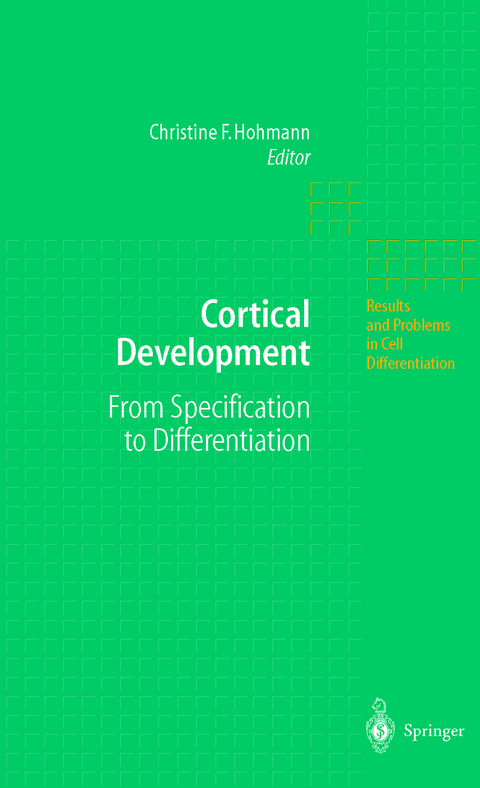
Cortical Development
Springer Berlin (Verlag)
978-3-540-43436-8 (ISBN)
Population Dynamics During Cell Proliferation and Neuronogenesis in the Developing Murine Neocortex.- References.- Mechanisms Regulating Lineage Diversity During Mammalian Cerebral Cortical Neurogenesis and Gliogenesis.- 1 Stem Cell Biology and Neural Development.- 2 Neural Lineage Elaboration and Bone Morphogenetic Proteins.- 3 Environmental and Transcriptional Regulation of Intermediate Progenitor Species.- 4 Mechanisms Regulating Neuronal and Astroglial Lineage Elaboration.- 5 Developmental Regulation and Lineage Potential of Radial Glia.- 6 Biology of Glial-Restricted Progenitors and the Generation of Oligodendrocytes.- 7 Role of ID Genes and Proteins in BMP-Mediated Cerebral Cortical Neural Fate Decisions.- 8 ID Genes and Proteins.- 9 Summary and Future Directions.- References.- Gap Junctions and Their Implications for Neurogenesis and Maturation of Synaptic Circuitry in the Developing Neocortex.- 1 Introduction.- 2 Expression of Gap Junctions in the Neocortex.- 3 Modulation of Gap Junction Permeability During Early Postnatal Stages of Neocortical Development.- 4 Functional Implications of Gap Junctions in the Developing Neocortex.- 5 Concluding Remarks.- References.- Influence of Radial Glia and Cajal-Retzius Cells in Neuronal Migration.- 1 Radial Glial Cells.- 2 Cajal-Retzius Cells and Reelin.- 3 MAM Model.- 4 What Prevents the Normal Laminar Pattern in E24 MAM-Treated Cortex?.- 5 Is There a Radialization Factor in Normal P) Cortex?.- 6 Summary and Conclusions.- References.- Neurotrophins and Cortical Development.- 1 Introduction.- 2 Distribution of the Neurotrophins and Their Receptors.- 3 Regulation of Synaptic Plasticity by the Neurotrophins.- 4 Neurotrophins and Structural Synaptic Plasticity.- 5 Concluding Remarks.- References.- Role of Immediate Early GeneExpression in Cortical Morphogenesis and Plasticity.- 1 Neural Activity Plays a Critical Role in the Development of the Cerebral Cortex.- 2 Learning and Development Share Mechanisms of Neural Plasticity.- 3 Molecular Events Underlying Cortical Plasticity: the Immediate Early Gene Response.- 4 Effector Neuronal Immediate Early Genes.- 5 Conclusions.- References.- Role of Afferent Activity in the Development of Cortical Specification.- 1 Introduction.- 2 Sensory Modalities: Vision and Audition.- 3 Intrinsic Determination of Modality-Specific Subregions of Cortex.- 4 A Role for Extrinsic Inputs in Specification of Local Cortical Networks.- References.- Regional Forebrain Patterning and Neural Subtype Specification: Implications for Cerebral Cortical Functional Connectivity and the Pathogenesis of Neurodegenerative Diseases.- 1 Introduction.- 2 Role of the Ventral Telencephalon in Cerebral Cortical Development.- 3 Developmental Actions of Neurogenic bHLH Genes.- 4 Mechanisms Regulating the Transition from Neurogenesis to Gliogenesis.- 5 Olig Genes and Regional Shh Signaling.- 6 Importance of Regional Forebrain Patterning for Neural Subtype Specification.- 7 Role of Local BMP Signaling in Cerebral Cortical Neuronal and OL Lineage Elaboration.- 8 Generation of OL Lineage Species in the Adult Brain: Therapeutic Implications.- 9 Role of Gap Junction Channels and GABAergic Neuronal Subtypes in Cerebral Cortical Functional Connectivity.- 10 Regional Forebrain Patterning and Neurodegenerative Diseases.- 11 Summary and Future Directions.- References.
| Erscheint lt. Verlag | 14.8.2002 |
|---|---|
| Reihe/Serie | Results and Problems in Cell Differentiation |
| Zusatzinfo | XIV, 181 p. |
| Verlagsort | Berlin |
| Sprache | englisch |
| Maße | 155 x 235 mm |
| Gewicht | 488 g |
| Themenwelt | Naturwissenschaften ► Biologie ► Genetik / Molekularbiologie |
| Naturwissenschaften ► Biologie ► Humanbiologie | |
| Naturwissenschaften ► Biologie ► Zellbiologie | |
| Schlagworte | brain • Cell Biology • Cortex • Development • Entwicklungsbiologie • Gehirn • gene expression • genes • Glia • Hirnrinde • Hirnrinde / Kortex • Influence • Kortex • Migration • Neocortex • Neurogenese • Neurogenesis • Neuron • Regulation • termination • transcription |
| ISBN-10 | 3-540-43436-4 / 3540434364 |
| ISBN-13 | 978-3-540-43436-8 / 9783540434368 |
| Zustand | Neuware |
| Informationen gemäß Produktsicherheitsverordnung (GPSR) | |
| Haben Sie eine Frage zum Produkt? |
aus dem Bereich


